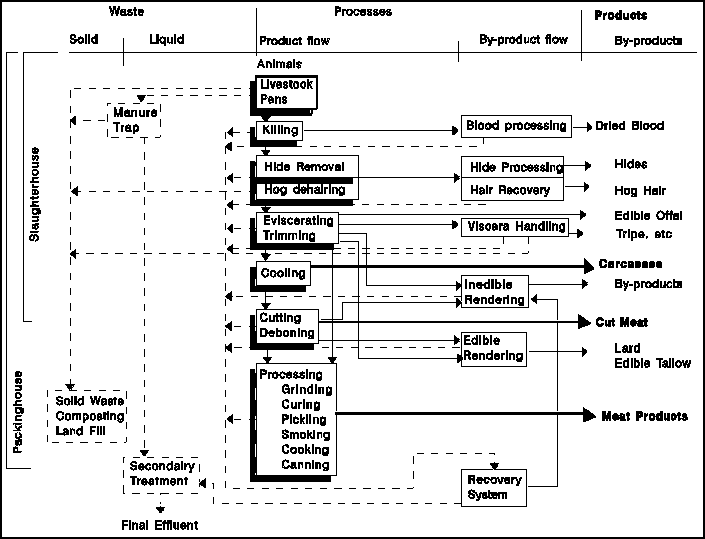In slaughterhouses animals are received and kept around in stockyards and pens for 1 day. The animals are watered, but in most cases not fed unless they are kept more than 1 day.
The animals are then driven from the holding pens to the slaughtering area where the following activities take place:

- Stunning;
- Suspension from an overhead rail by the hind legs;
- Sticking and bleeding over a collecting trough. The collected blood may be sewered or processed;
- Hide removal;
- Decapitation;
- Opening of the carcass by cutting;
- Inspection of the carcass;
- Evisceration (removal of intestines and internal organs);
- Splitting and cutting of the carcass; and
- Chilling or freezing.
Meatpacking
Many large scale plants ship whole graded carcasses to retail markets, others perform some on-site processing to produce retail cuts. The processes are the following:
– Cutting and deboning; and
– Meat processing. This includes a variety of operations amongst which grinding, mixing with additives, curing, pickling, smoking, cooking and canning.
Rendering
Rendering is a heating process for meat industry waste products through which fats are separated from water and protein residues for the production of edible lards and dried protein residues. Commonly it includes the production of a range of products of meat meal, meat-cum-bone meal, bone meal and fat from animal tissues. It does not include processes where no fat is recovered.
There are basically two different rendering processes:
– High temperature rendering: through cooking or steam application (5 systems are known: (1) simple cooking; (2) open pan rendering; (3) kettle rendering; (4) wet rendering; and (5) dry rendering.)
– Low temperature rendering (around 80°C). This process requires finely ground material and temperatures slightly above the fat melting point. It results in a better quality lard. The rendering at low temperatures is a highly sophisticated process requiring large throughputs and trained personnel. For many developing countries the system is not suitable. (Kumar, undated).

Handling of viscera, paunch and intestines
Viscera can be recovered as edible products (e.g. heart, liver). They can also be separated for inedible rendering or processing (e.g. lungs).
The paunch contents, ‘paunch manure’ (partially digested feed), is estimated to range from 27 to 40 kg. The paunch can be handled in four ways:
1: Total dumping. All of the paunch contents is flushed away into the sewer.
2: Wet dumping. The paunch contents are washed out and the wet slurry is screened on the presence of gross solids, which are subsequently removed.
3: Dry dumping. The paunch contents are dumped for subsequent rendering or for disposal as solid waste without needless water flushing.
4: Whole paunch handling. The entire paunch may be removed, intact, for rendering or for disposal as solid waste.
Intestines may be rendered directly, or hashed and washed prior to rendering. For the processing of intestines de-sliming prior to thorough washing is necessary.
Categories of slaughter-plants
Plants for red meat slaughtering may be categorized on the basis of the final products. A plant that processes meat into products such as canned, smoked and cured meats is significantly different from a plant with facilities for slaughtering without further processing.
Slaughterhouses and packinghouses (slaughtering and meat processing) may each be divided into two categories on the basis of the quantity of waste produced.
Slaugtherhouses:
– Simple slaughterhouse:
A plant that slaughters animals and does a very limited amount of by-product processing. Its main products are fresh meat in the form of whole, half or quarter carcasses or in smaller meat cuts.
– Complex slaughterhouse:
A plant that slaughters and does extensive processing of by-products. Usually at least three of the following operations take place: rendering, paunch and viscera handling, blood processing, and hide and hair processing.
Packinghouses
– Low-processing packinghouse:
A plant that both slaughters and processes fresh meat into cured, smoked, canned and other meat products. Only the meat from animals slaughtered at the plant is processed. Carcasses may also be sold.
– High-processing packinghouse:
A plant that also processes meat purchased from outside. Sometimes, a high-process packinghouse has facilities for tanning operations.
There are also plants that do not slaughter themselves but restrict their activities to the processing of meat (meatpacking). These plants have a waste production comparable to that of a simple slaughterhouse.


It is actually a nice and helpful piece of information. I am happy that you just shared this helpful information with us. Please stay us up to date like this. Thanks for sharing.
Hi,That nice post Tks
meuble salle de bain pas cher http://www.meuble-salle-de-bain-pas-cher.fr/
It¡¯s actually a nice and useful piece of information. I am glad that you just shared this useful info with us. Please stay us informed like this. Thank you for sharing.
I simply want to mention I am just beginner to blogging and site-building and certainly enjoyed your web page. More than likely I’m likely to bookmark your website . You amazingly have incredible articles. Thank you for sharing your web-site.